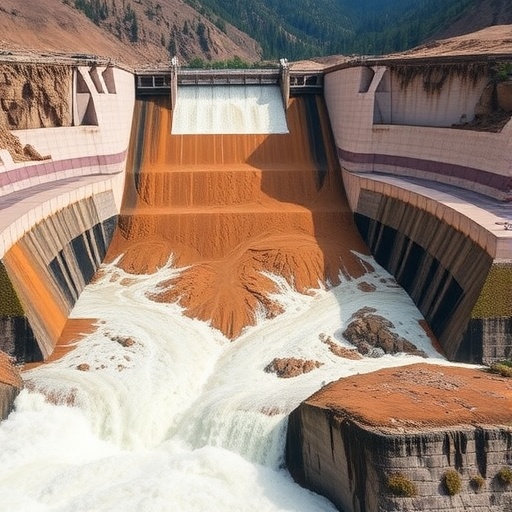In recent years, the catastrophic failure of tailings dams has drawn significant attention from both the scientific community and the public due to the devastating environmental and human impacts associated with such events. A groundbreaking study led by Zhao, Deng, Chen, and their colleagues has provided new insights into the mechanisms behind overtopping failures in tailings dams, exploring how flow velocity and concentration profoundly influence these critical events. Published in Environmental Earth Sciences, this research has undergone a rigorous correction process to refine the understanding of these dynamics, highlighting the intricate physical processes that govern dam stability under extreme flow conditions.
Tailings dams, which are engineered structures designed to contain mining by-products, are inherently complex systems due to the heterogeneous nature of the stored materials combined with fluctuating hydrological conditions. The overtopping failure mechanism occurs when water flows over the top of a dam, eroding the structure and triggering a breach. This failure mode has been implicated in several high-profile disasters worldwide, which has prompted the researchers to dissect the roles of flow velocity and sediment concentration within overtopping flows to assess their contributions to dam breach initiation and progression.
The crucial premise underlying this study is that both flow velocity and concentration of suspended materials within the overtopping flow alter the erosive capacity exerted on the dam crest and downstream slopes. By systematically varying these parameters, the research elucidates how faster flow velocities amplify shear stress and hydraulic forces, directly correlating to accelerated material removal from the dam surface. Concurrently, higher sediment concentrations increase the flow’s abrasive power, enhancing the mechanical degradation of the exposed layers of the dam, thereby compounding the erosion effects instigated by velocity alone.
To unravel the complexity of these interactions, the research team employed advanced experimental setups that simulate overtopping scenarios with controlled variations of flow parameters. High-resolution sensors and imaging techniques captured the progressive morphological changes to the model dam structures under different flow conditions. These intricately designed experiments revealed that the synergistic interaction between velocity and concentration does not produce simple additive effects but rather induces nonlinear erosion responses that challenge existing predictive models.
One of the most striking revelations is the discovery that beyond a certain threshold of flow concentration, the erosion rate plateaus or even declines slightly because increased sediment loading can induce a form of flow thickening, which somewhat cushions the dam surface from direct hydraulic attack. This counterintuitive phenomenon underscores the necessity of integrating complex fluid-solid interaction mechanisms into the theoretical frameworks governing tailings dam stability assessment.
The implications of these findings are far-reaching for the mining industry and regulatory bodies. Current risk assessment models used to predict dam overtopping likelihood and subsequent failure often oversimplify the erosive dynamics, potentially underestimating the true hazard in scenarios characterized by rapid and sediment-rich overtopping flows. Zhao and colleagues’ work advises incorporating these nuanced parameters into comprehensive risk models to enhance early warning capabilities and strengthen preventative engineering designs.
Moreover, the research advances the development of tailored mitigation strategies aimed at minimizing overtopping consequences. For example, engineering adaptive surface armoring or strategically modulating upstream reservoir release rates can be informed by the identified critical thresholds of flow velocity and concentration. Such proactive interventions could serve as practical applications to reinforce vulnerable dam segments expressly under predicted extreme weather events or operational changes.
The study also highlights the vital role of continuous monitoring technologies, such as real-time flow velocity and sediment concentration measurements upstream of tailings dams. These data feeds can empower plant operators with timely, actionable intelligence enabling them to initiate emergency protocols before overtopping begins or escalates beyond control. This approach aligns with the broader movement towards smart mining infrastructure employing digital twins and predictive analytics.
On a broader scientific plane, the enhanced understanding of overtopping erosion enriches fundamental sediment transport research. The unique characteristics of laminar versus turbulent overtopping flows, especially in sediment-laden contexts, provide valuable case studies that can deepen comprehension of geomorphological processes beyond mining applications. Insights garnered here may find relevance in riverbank stability, coastal erosion, and dam safety across diverse environments.
Importantly, this research also dovetails with concerns about climate change-induced hydrological extremes, which are anticipated to increase the frequency and intensity of precipitation events. With more frequent high-magnitude floods, the probability of overtopping events rises correspondingly, elevating tailings dam failures as a pressing environmental risk. Zhao and his team’s study provides a timely scientific foundation to anticipate and mitigate these heightened threats in the coming decades.
Beyond technical contributions, the study serves as a clarion call for multidisciplinary collaboration integrating civil engineering, hydrology, sedimentology, and environmental safety. The challenge posed by overtopping failures demands expertise that spans designing robust infrastructure to understanding the ecological repercussions of dam breaks, reinforcing the value of systemic approaches when addressing such multifaceted hazards.
In conclusion, Zhao et al.’s correction clarifies previous understandings and advances a more sophisticated, experimentally validated framework to predict and mitigate the overtopping failure of tailings dams. The nuanced appreciation of how flow velocity and concentration interact to alter erosive forces enhances predictive accuracy and informs safer engineering design, real-time monitoring strategies, and regulatory guidelines. This research exemplifies how meticulous, data-driven inquiry can transform hazard management in critical industrial infrastructures, protecting ecosystems and communities alike.
Subject of Research: Overtopping failure mechanisms of tailings dams focusing on the effects of flow velocity and sediment concentration.
Article Title: Correction: Effects of flow velocity and concentration on the overtopping failure mechanism of tailings dams.
Article References:
Zhao, K., Deng, Z., Chen, S. et al. Correction: Effects of flow velocity and concentration on the overtopping failure mechanism of tailings dams. Environ Earth Sci 84, 551 (2025). https://doi.org/10.1007/s12665-025-12613-6
Image Credits: AI Generated




